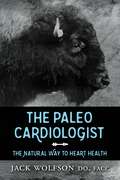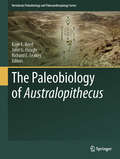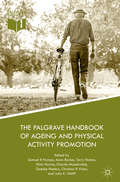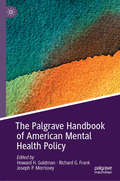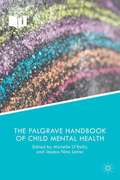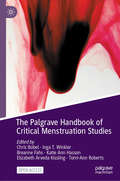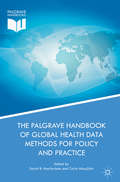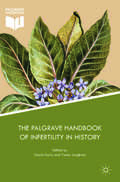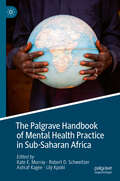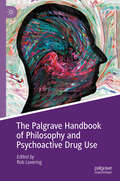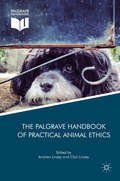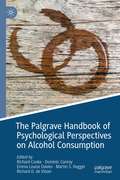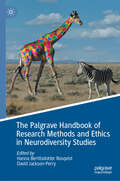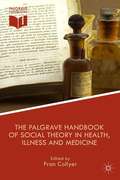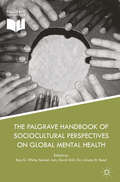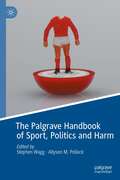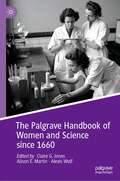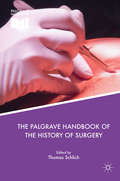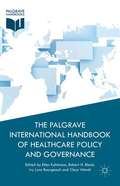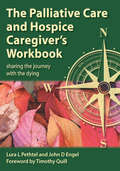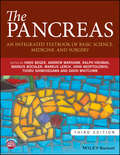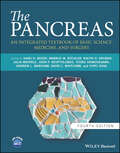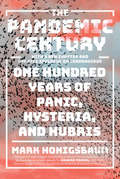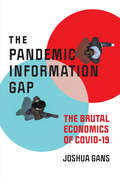- Table View
- List View
The Paleo Cardiologist: The Natural Way to Heart Health
by Jack WolfsonThe Paleo Cardiologist," you will learn: 1) Paleo Nutrition is the food plan for health, 2) The importance of cholesterol to every cell in the body, 3) How to avoid pharmaceuticals and skip the dangerous procedures, 4) Why stress is bad for your heart and how to relax, 5) How to get rid of the chemicals and heavy metals, 6) Sleep is critical for heart health and how to get more Z's, 7) The Top 20 supplements for heart health, 8) The Top 20 blood tests you need.
The Paleobiology of Australopithecus
by Richard E. Leakey Kaye E. Reed John G. FleagleAustralopithecus species have been the topic of much debate in palaeoanthropology since Raymond Dart described the first species, Australopithecus africanus, in 1925. This volume synthesizes the geological and paleontological context of the species in East and South Africa; covers individual sites, such as Dikika, Hadar, Sterkfontein, and Malapa; debates the alpha taxonomy of some of the species; and addresses questions regarding the movements of the species across the continent. Additional chapters discuss the genus in terms of sexual dimorphism, diet reconstruction using microwear and isotopic methodologies, postural and locomotor behavior, and ontogeny.
The Palgrave Handbook of Ageing and Physical Activity Promotion
by Christina R. Victor Charles Musselwhite Samuel R. Nyman Anna Barker Terry Haines Khim Horton Geeske Peeters Julia Katharina WolffThe ageing of our population is a key societal issue across the globe. Although people are living longer, they need to be living longer in good health to continue to enjoy quality of life and independence and to prevent rises in health and social care costs. This timely and ground-breaking volume will provide an up-to-date overview of the factors that promote physical activity in later life. Despite advances in the fields of gerontology and geriatrics, sports and exercise science, sociology, health psychology, and public health, knowledge is largely contained within disciplines as reflected in the current provision of academic texts on this subject. To truly address the present and substantial societal challenges of population ageing, a multidisciplinary and collaborative approach is required. This handbook will inform researchers, students, and practitioners on the current evidence base for what physical activities need to be promoted among older people and how they can be implemented to maximise engagement. This handbook will be an invaluable resource for researchers, practitioners, policy makers, and students across the social sciences.
The Palgrave Handbook of American Mental Health Policy
by Howard H. Goldman Richard G. Frank Joseph P. MorrisseyThis handbook is the definitive resource for understanding current mental health policy controversies, options, and implementation strategies. It offers a thorough review of major issues in mental health policy to inform the policy-making process, presenting the pros and cons of controversial, significant issues through close analyses of data. Some of the topics covered are the effectiveness of various biomedical and psychosocial interventions, the role of mental illness in violence, and the effectiveness of coercive strategies. The handbook presents cases for conditions in which specialized mental health services are needed and those in which it might be better to deliver mental health treatment in mainstream health and social services settings. It also examines the balance between federal, state, and local authority, and the financing models for delivery of efficient and effective mental health services. It is aimed for an audience of policy-makers, researchers, and informed citizens that can contribute to future policy deliberations.
The Palgrave Handbook of Child Mental Health
by Jessica Nina Lester Michelle O�reillyThis Handbook illustrates the importance of examining child mental health from a different perspective, one that assumes that psychiatric categories are made real in and through both written and spoken language. It gathers a range of applied and theoretical analyses from leading scholars and clinicians in order to examine the conversational practices of children diagnosed with mental health disorders alongside those of their parents, families and practitioners. The contributors move away from viewing mental illness as an objective truth; instead reintroducing the relevance of language in constructing and deconstructing the assumptions that surround the diagnosis and treatment of childhood mental health disorders. Including chapters on ADHD, autism, depression, eating disorders and trauma, this collection addresses the diversity involved in discussing child mental health. Divided into six parts: the place of conversation/discourse analysis; critical approaches; social constructions of normal/abnormal; situating and exploring the difficulties involved; managing problem behaviour and discussing different practices involved; this Handbook presents a comprehensive overview of child mental health. It is an essential reference resource for all those involved or interested in child mental health.
The Palgrave Handbook of Critical Menstruation Studies
by Breanne Fahs Tomi-Ann Roberts Chris Bobel Inga T. Winkler Katie Ann Hasson Elizabeth Arveda KisslingThis open access handbook, the first of its kind, provides a comprehensive and carefully curated multidisciplinary and genre-spanning view of the state of the field of Critical Menstruation Studies, opening up new directions in research and advocacy. It is animated by the central question: ‘“what new lines of inquiry are possible when we center our attention on menstrual health and politics across the life course?” The chapters—diverse in content, form and perspective—establish Critical Menstruation Studies as a potent lens that reveals, complicates and unpacks inequalities across biological, social, cultural and historical dimensions. This handbook is an unmatched resource for researchers, policy makers, practitioners, and activists new to and already familiar with the field as it rapidly develops and expands.
The Palgrave Handbook of Gender and Healthcare
by Ellen Kuhlmann Ellen AnnandaleAn authoritative, state-of-the-art collection that brings together key experts to provide an overview of the field. This new paperback edition includes 3 new chapters on human resources and health, end-of-life care and complementary and alternative medicine as well as thorough updates to the introduction and conclusion.
The Palgrave Handbook of Global Health Data Methods for Policy and Practice
by Sarah B. Macfarlane Carla AbouZahrThis handbook compiles methods for gathering, organizing and disseminating data to inform policy and manage health systems worldwide. Contributing authors describe national and international structures for generating data and explain the relevance of ethics, policy, epidemiology, health economics, demography, statistics, geography and qualitative methods to describing population health. The reader, whether a student of global health, public health practitioner, programme manager, data analyst or policymaker, will appreciate the methods, context and importance of collecting and using global health data.
The Palgrave Handbook of Infertility in History: Approaches, Contexts and Perspectives
by Tracey Loughran Gayle DavisThis ground-breaking, interdisciplinary volume provides an overdue assessment of how infertility has been understood, treated and experienced in different times and places. It brings together scholars from disciplines including history, literature, psychology, philosophy, and the social sciences to create the first large-scale review of recent research on the history of infertility. Through exploring an unparalleled range of chronological periods and geographical regions, it develops historical perspectives on an apparently transhistorical experience. It shows how experiences of infertility, access to treatment, and medical perspectives on this ‘condition’ have been mediated by social, political, and cultural discourses. The handbook reflects on and interrogates different approaches to the history of infertility, including the potential of cross-disciplinary perspectives and the uses of different kinds of historical source material, and includes lists of research resources to aid teachers and researchers. It is an essential ‘go-to’ point for anyone interested in infertility and its history. Chapter 19 is open access under a CC BY 4.0 license via link.springer.com.
The Palgrave Handbook of Mental Health Practice in Sub-Saharan Africa
by Kate E. Murray Robert D. Schweitzer Ashraf Kagee Lily KpobiThe focus of this handbook is to highlight the key issues in addressing the challenges and opportunities to promote mental health is Sub-Saharan Africa. A unique feature of this work is the privileging of African voices in expressing the strengths, vulnerabilities, and unique approaches which have been found within the Sub-Saharan context. The handbook is broken into three sections. The first introduces the handbook and the general issues and concepts discussed. The second describes diverse community outreach and mental health interventions applied by the contributors in diverse Sub-Saharan Africa countries and contexts and addressing a range of mental health topics. The third focuses on systemic issues that affect mental health service delivery, with recommendations provided. Opportunities for creating new models for sharing practices and disseminating knowledge generated by Sub-Saharan African practitioners for their culture and contexts are discussed.
The Palgrave Handbook of Philosophy and Psychoactive Drug Use
by Rob LoveringIn this Handbook, philosophers from around the world address the metaphysics, epistemology, and value of psychoactive (mind-altering) drug use. In so doing, they attempt to answer questions such as: What does the fact of drug-induced mind-altering experiences tell us about natures of the mind, free will, and God? What does it tell us about what, and how, we can know? Are drug-induced mind-altering experiences valuable, morally, aesthetically, or otherwise? Is the acquisition of drug-induced mind-altering experiences ever immoral? Should the acquisition of drug-induced mind-altering experiences ever be legally prohibited? The Handbook gives an overview of the current research, and sets the stage for future directions in philosophical thought relating to psychoactive drug use.
The Palgrave Handbook of Practical Animal Ethics (The Palgrave Macmillan Animal Ethics Series)
by Andrew Linzey Clair LinzeyThis handbook provides an in-depth examination of the practical and theoretical issues within the emerging field of animal ethics. Leading experts from around the globe offer insights into cutting edge topics as diverse as killing for food, religious slaughter, animal companions, aquariums, genetic manipulation, hunting for sport and bullfighting. Including contributions from Lisa Johnson on the themes of human dominance, Thomas White on the ethics of captivity, Mark Bernstein on the ethics of killing and Kay Peggs on the causation of suffering, this handbook offers an authoritative reference work for contemporary applied animal ethics. Progressive in approach, the authors explore the challenges that animal ethics poses both conceptually and practically to traditional understandings of human–animal relations. Key Features: · Structured in four parts to examine the ethics of control, the ethics of captivity, the ethics of killing and the ethics of causing suffering · Interdisciplinary approach including philosophical, historical, scientific, legal, anthropological, religious, psychological and sociological perspectives · Focussed treatment of practical issues such as animals in farming, zoos and animal experimentation The Palgrave Handbook of Practical Animal Ethics is an essential resource for those with an interest in the ethics of modern-day treatment of animals as well as scholars, researchers and advanced students in zoology, philosophy, anthropology, religious studies and sociology.
The Palgrave Handbook of Psychological Perspectives on Alcohol Consumption
by Dominic Conroy Martin S. Hagger Richard Cooke Emma Louise Davies Richard O. de VisserThis Handbook provides a broad and comprehensive overview of psychological research on alcohol consumption. It explores the psychological theories underpinning alcohol use and misuse, discusses the interventions that can be designed around these theories, and offers key insight into future developments within the field.A range of international experts assess the unique factors that contribute to alcohol-related behaviour as differentiated from other health-related behaviours. They cover the theory and context of alcohol consumption, including possible implications of personality type, motivation and self-regulation, and cultural and demographic factors. After reviewing the evidence for psychological theories and predictors as accounts for alcohol consumption, the book goes on to focus on external influences on consumption and interventions for reducing alcohol consumption, including those based on purchasing and consumption behaviour, technologies such as personalised feedback apps, and social and media phenomena such as “Dry January” and “Hello Sunday Morning”. It brings together cutting-edge contemporary research on alcohol consumption in childhood and adolescence, including topics such as managing offers or drinks, “pre-drinking”, online identities, how children develop their beliefs about alcohol and how adolescents discuss alcohol with their parents. The book also offers a rounded presentation of the tensions involved in debates around the psychological impacts of alcohol use, discussing its role in helping people to socialise and unwind; as well as recognising the possible negative impacts on health, education and relationships. This book will be of interest to academics, policymakers, public health officials, practitioners, charities and other stakeholders interested in understanding how alcohol affects people psychologically. This book will also be a key resource for students and researchers from across the social sciences.
The Palgrave Handbook of Research Methods and Ethics in Neurodiversity Studies
by Hanna Bertilsdotter Rosqvist David Jackson-PerryThis timely volume brings together well-established scholars and emerging voices to explore research methods and ethics in Neurodiversity Studies. It explores the epistemic injustice that currently surrounds much knowledge production around neurodivergence, and offers concrete examples of creative, participatory, and collaborative research practice in the field. The editors have assembled chapters combining reflexive, theoretical, and practical contributions. Together they address current debates surrounding participatory methods and Neurodiversity Studies and are unique in giving voice to mainly neurodivergent researchers and contributors across autism, ADHD, acquired brain injury, and multiple neurodivergence. The first of its kind, this much-needed volume contains essential reading for all those learning and teaching in the field of neurodiversity. It further represents a valuable resource for students and academics at all levels, participatory or creative researchers, research commissioners, and research evidence users across the social sciences.
The Palgrave Handbook of Social Theory in Health, Illness and Medicine
by Fran CollyerThis wide-reaching handbook offers a new perspective on the sociology of health, illness and medicine by stressing the importance of social theory. Examining a range of classic and contemporary female and male theorists from across the globe, it explores various issues including chronic illness, counselling and the rising problems of obesity.
The Palgrave Handbook of Sociocultural Perspectives on Global Mental Health
by Ross G. White Sumeet Jain David M.R. Orr Ursula M. ReadThis handbook incisively explores challenges and opportunities that exist in efforts aimed at addressing inequities in mental health provision across the globe. Drawing on various disciplines across the humanities, psychology, and social sciences it charts the emergence of Global Mental Health as a field of study. It critically reflects on efforts and interventions being made to globalize mental health policies, and discusses key themes relevant for understanding and supporting the mental health needs of people living in diverse socio-economical and cultural environments. Over three rich sections, the handbook critically engages with Global Mental Health discourses. To help guide future efforts to support mental health and wellbeing in different parts of the world, the third section of the handbook consists of case studies of innovative mental health policy and practice, which are presented from a variety of different perspectives. <P><P> This seminal handbook will appeal to a transnational community of post-graduate students, academics and practitioners, from global health to transcultural psychiatry and medical anthropology. It will be also of interest to researchers and clinical practitioners, policy makers and non-governmental organisations involved in cross-cultural mental health work.
The Palgrave Handbook of Sport, Politics and Harm
by Stephen Wagg Allyson M. PollockThis book looks historically at the harm that has been inflicted in the practice of sport and at some of the issues, debates and controversies that have arisen as a result. Written by experts in history, sociology, sport journalism and public health, the book considers sport and injury in relation to matters of social class; gender; ethnicity and race; sexuality; political ideology and national identity; health and wellbeing; childhood; animal rights; and popular culture. These matters are, in turn, variously related to a range of sports, including ancient, pre- and early industrial sports; American football; boxing; wrestling and other combat sports; mountaineering; horseracing; cycling; motor racing; rugby football; cricket; association football; baseball; basketball; Crossfit; ice hockey; Olympic sports; Mixed Martial Arts; and sport in an imagined dystopian future.
The Palgrave Handbook of Women and Science since 1660
by Alison E. Martin Claire G. Jones Alexis WolfThis handbook provides a comprehensive overview of core areas of investigation and theory relating to the history of women and science. Bringing together new research with syntheses of pivotal scholarship, the volume acknowledges and integrates history, theory and practice across a range of disciplines and periods. While the handbook’s primary focus is on women's experiences, chapters also reflect more broadly on gender, including issues of femininity and masculinity as related to scientific practice and representation. Spanning the period from the birth of modern science in the late seventeenth century to current challenges facing women in STEM, it takes a thematic and comparative approach to unpack the central issues relating to women in science across different regions and cultures. Topics covered include scientific networks; institutions and archives; cultures of science; science communication; and access and diversity. With its breadth of coverage, this handbook will be the go-to resource for undergraduates taking courses on the history and philosophy of science and gender history, while at the same time providing the foundation for more advanced scholars to undertake further historical and theoretical investigation.
The Palgrave Handbook of the History of Surgery
by Thomas SchlichThis handbook covers the technical, social and cultural history of surgery. It reflects the state of the art and suggests directions for future research. It discusses what is different and specific about the history of surgery - a manual activity with a direct impact on the patient's body. The individual entries in the handbook function as starting points for anyone who wants to obtain up-to-date information about an area in the history of surgery for purposes of research or for general orientation. Written by 26 experts from 6 countries, the chapters discuss the essential topics of the field (such as anaesthesia, wound infection, instruments, specialization), specific domains areas (for example, cancer surgery, transplants, animals, war), but also innovative themes (women, popular culture, nursing, clinical trials) and make connections to other areas of historical research (such as the history of emotions, art, architecture, colonial history). Chapters 16 and 18 of this book are available open access under a CC BY 4. 0 license at link. springer. com
The Palgrave International Handbook of Healthcare Policy and Governance
by Claus Wendt Ellen Kuhlmann Robert H. Blank Ivy Lynn BourgeaultStarting with more general issues of healthcare policy and governance in a global perspective and using the lens of national case studies of healthcare reform, this handbook addresses key themes in the debates over changing healthcare policy.
The Palliative Care and Hospice Caregiver's Workbook: Sharing the Journey with the Dying
by John D Engel Lura L PethtelThis educational workbook helps people who build compassionate relationships with dying people. Accompanied by its trainer's guide, it presents a comprehensive, sequential learning program for caregivers in non-medical capacities covering everything from self-understanding to spiritual issues, listening skills and expressive activities, developing the skills, awareness and resilience needed for this privileged and sensitive role. The program includes a variety of learning experiences, including large and small group activities, discussion, close reading, creative writing, self exploration, and skill development and practice. This is an invaluable resource for small groups of individuals who wish to volunteer in hospice or palliative care settings. A copy of the guide for trainers is included in each pack of workbooks, and is also freely available online. 'The best resource I have seen to guide teachers and learners in this complex training process. I predict that those of you who try it with your staffs and trainees will find that it bears fruit both for your patients and their families, but also for the sustenance and personal development of the staff members themselves.' Timothy Quill, M.D., in his Foreword
The Pancreas: An Integrated Textbook of Basic Science, Medicine, and Surgery
by John P. Neoptolemos Hans G. Beger Markus M. Lerch Ralph H. Hruban Andrew L. Warshaw Markus W. Buchler Tooru Shimosegawa David C. WhitcombThis brand new updated edition of the most comprehensive reference book on pancreatic disease details the very latest knowledge on genetics and molecular biological background in terms of anatomy, physiology, pathology, and pathophysiology for all known disorders. Included for the first time, are two brand new sections on the key areas of Autoimmune Pancreatitis and Benign Cystic Neoplasms. In addition, this edition is filled with over 500 high-quality illustrations, line drawings, and radiographs that provide a step-by-step approach to all endoscopic techniques and surgical procedures. Each of these images can be downloaded via an online image bank for use in scientific presentations. Every existing chapter in The Pancreas: An Integrated Textbook of Basic Science, Medicine and Surgery, 3rd Edition has been thoroughly revised and updated to include the many changes in clinical practice since publication of the current edition. The book includes new guidelines for non-surgical and surgical treatment; new molecular biologic pathways to support clinical decision making in targeted treatment of pancreatic cancer; new minimally invasive surgical approaches for pancreatic diseases; and the latest knowledge of neuroendocrine tumors and periampullary tumors. The most encyclopedic book on the pancreas—providing outstanding and clear guidance for the practicing clinician Covers every known pancreatic disorder in detail including its anatomy, physiology, pathology, pathophysiology, diagnosis, and management Completely updated with brand new chapters Over 500 downloadable illustrations An editor and author team of high international repute who present global best-practice The Pancreas: An Integrated Textbook of Basic Science, Medicine and Surgery, 3rd Edition is an important book for gastroenterologists and gastrointestinal surgeons worldwide.
The Pancreas: An Integrated Textbook of Basic Science, Medicine, and Surgery
by Hans G. BegerThe PANCREASThe newest edition of the essential guide to pancreatic medicine The fourth edition of The Pancreas: An Integrated Textbook of Basic Science, Medicine, and Surgery integrates the cutting-edge research of recent years to update its presentation of this fast-growing subject. It details every known disorder of the pancreas, grounding them in a thorough understanding of pancreatic function, enhanced with high quality illustration and graphs. It also includes step-by-step guidance for relevant endoscopic techniques and surgical procedures. The Pancreas readers will also find: New comprehensive insights into three pancreatic diseases: autoimmune pancreatitis, cystic neoplasms, and neuroendocrine tumors An editorial team with decades of clinical and research experience in the US, Europe, and Asia Over 500 downloadable illustrations for use in scientific presentations The Pancreas is a foundational reference for clinicians and researchers in gastroenterology and gastrointestinal surgery.
The Pandemic Century: One Hundred Years Of Panic, Hysteria, And Hubris
by Mark HonigsbaumA medical historian narrates the last century of scientific struggle against an enduring enemy: deadly contagious disease. Ever since the 1918 Spanish influenza pandemic, scientists have dreamed of preventing catastrophic outbreaks of infectious disease. Yet despite a century of medical progress, viral and bacterial disasters continue to take us by surprise, inciting panic and dominating news cycles. From the Spanish flu to the 1924 outbreak of pneumonic plague in Los Angeles to the 1930 “parrot fever” pandemic, through the more recent SARS, Ebola, and Zika epidemics, the last one hundred years have been marked by a succession of unanticipated pandemic alarms. In The Pandemic Century, a lively account of scares both infamous and less known, Mark Honigsbaum combines reportage with the history of science and medical sociology to artfully reconstruct epidemiological mysteries and the ecology of infectious diseases. We meet dedicated disease detectives, obstructive or incompetent public health officials, and brilliant scientists often blinded by their own knowledge of bacteria and viruses. We also see how fear of disease often exacerbates racial, religious, and ethnic tensions—even though, as the epidemiologists Malik Peiris and Yi Guan write, “‘nature’ remains the greatest bioterrorist threat of all.” Like man-eating sharks, predatory pathogens are always present in nature, waiting to strike; when one is seemingly vanquished, others appear in its place. These pandemics remind us of the limits of scientific knowledge, as well as the role that human behavior and technologies play in the emergence and spread of microbial diseases.
The Pandemic Information Gap: The Brutal Economics of COVID-19
by Joshua GansWhy solving the information problem should be at the core of our pandemic response: essential reading about the long-term implications of our current crisis.COVID-19 is caused by a virus. The COVID-19 pandemic is caused by a lack of good information. A pandemic is essentially an information problem: this is the enlightening and provocative idea at the heart of this book. If we solve the information problem, argues economist Joshua Gans, we can defeat the virus. For example, when we don't know who is infected, we have to act as if everyone is infected. If we actively manage the information problem--if we know who is infected and with whom they had contact--we can suppress the virus or buy time for vaccine development.This is an expanded version of an eBook originally published as Economics in the Age of COVID-19.
